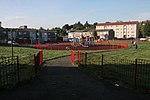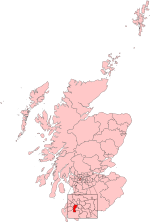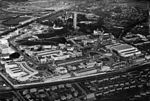Bellahouston Park (Scottish Gaelic: Pàirc Bhaile Ùisdean) is a public park in the Bellahouston district on the South Side of Glasgow, Scotland, between the areas of Craigton, Dumbreck, Ibrox and Mosspark covering an area of 71 hectares (180 acres). The main part of Bellahouston Park was acquired by Glasgow Corporation in 1895 for the sum of £50,000, and opened to the public in 1896. Three years later, the city's second municipal golf course was established at Bellahouston, following the success of the course at Alexandra Park. The park was extended in 1901 by the addition of a part of Dumbreck Lands purchased for £2,824 from Sir John Stirling-Maxwell. A further addition was made in 1903, at a cost of £40,222, by including the lands of Ibroxhill, from which commanding views of the city are available.
In 1938 the Empire exhibition was held at the park. The site took fourteen months to build. The price of admission was one shilling, and 12.5 million visits were recorded. The exhibition made a loss of £130,000. Of the 200 palaces and pavilions that were built for the exhibition, only the Palace of Art remains. It now serves as a Sports Excellence Centre. A stone Peace Cairn built for the exhibition is still visible from the rock garden.
In 1996 Charles Rennie Mackintosh's House for an Art Lover was completed from original drawings of 1901, and now serves as centre for the visual arts. It is based around Bella hill, created for the great Empire Exhibition. It has commanding views over most of the city, although views to the east are obscured by trees, and those to the south by hills in Mosspark. Views include that of Ballageich (Balagich) hill, rising to 1,084 feet (330 m) on the southern horizon in East Renfrewshire.







